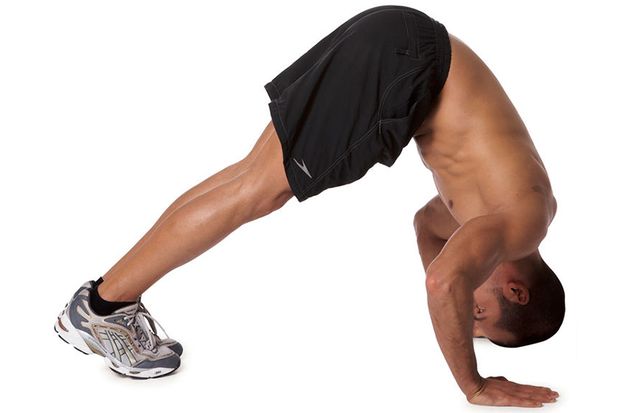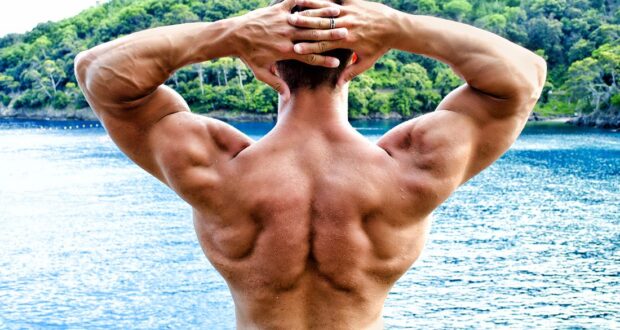A real lift – without strong shoulders, you can forget about the next visit to the bar or buddy celebrating birthday. Because this part is involved in almost every arm movement. You also score with women with broad shoulders and get past the bouncer more easily.
Why do I benefit from strong shoulder muscles?
A lot is easier for you with strong shoulders. For example, pushing the car out of the mud. Or to whirl your children through the air. Even if they are about to graduate. Seriously, your shoulders are involved in just about every arm movement. They are already in use when pulling your sweater over your head or when you take the corn flakes pack from the upper shelf. They also support you in every strength training for the upper body. Because as soon as you do exercises for the chest or back, strong shoulders allow more weight and thus a greater effect. It also doesn’t hurt to never have to complain about tense shoulders. After all, strong muscles don’t know pain. By the way, these are the best exercises for back pain. If you’re struggling with extra pounds in your stomach area: Broad shoulders hide them better than any baggy sweater. Thanks to the resulting V-shape, your waist looks slimmer.
What are the benefits of shoulder training?
It depends on. You should know that the shoulder is divided into 3 areas: the front, side and back. The side section in particular makes the shoulder appear more voluminous. Of course only if it is trained. Exercises for the rear area ensure that you don’t go through life like a limp sack with sagging shoulders. And those who specifically train the front shoulder area have a good chance of winning beer mug lifting.

The shoulder is divided into 3 areas: the front, side and back
Which muscles do I train?
Several. On the one hand, of course, the shoulder muscles themselves. It bears the name “Musculus Deltoideus”. This triangular muscle divides – as mentioned above – into the front, side and rear areas. However, the so-called rotator cuff is much more important for the smooth flow of shoulder work. The cuff stabilizes the shoulder joint by resting on the shoulder joint like a cap. In this way, the joint button of the humerus remains in the center of the socket of the shoulder blade. The four muscles allow you to rotate your arms in and out. Lifting from the side is also part of their job profile. If you want to know exactly: The quartet consists of the lower and upper bone muscles (infraspinatus and supraspinatus muscles) the subscapular muscle (Musculus subscapularis) and the small round muscle (Musculus teres minor) together. By the way, holistic shoulder training also includes training the hood muscle. It lifts your shoulders, moves your shoulder blades and mixes in when you turn your head. Incidentally, bodybuilders’ hunched shoulders come from neglecting their trapezius muscles.These exercises improve posture . Even if you have no ambitions to be on stage, you should include the trapeze in your training, as it promotes tension in the neck area when it is weak.
Why are the shoulders particularly prone to injury?
Their agility is to blame. The shoulder joint is the most mobile joint of all. But: This flexibility has disadvantages. It is made possible by the socket of the shoulder joint, which is small compared to the hip joint. This means that the shoulder joint is only weakly guided on the bone side and relies on muscular support. If this is missing, tension or injury is not far off. If only because the joint is constantly in use and one-sided loads are not uncommon in our everyday lives. Overloads can also be the cause. In addition, people who are naturally more flexible (keyword: hypermobility) run the risk of the joint completely dislocating. The reason for this are extreme movements, such as those caused by an accident. Once the shoulder is hurt you should definitely make sure to cure them completely and strengthen them in the next step through targeted training. Precisely because the joint is so vulnerable, it makes any impairment even more sensitive.
What is shoulder impingement syndrome all about?
With impingement syndrome (also called bottleneck syndrome) things get tight – in the spaces in and around the shoulder joint or in the area under the shoulder roof. This lack of space can be caused by sloping shoulders, i.e. poor posture. Other causes are also overload (for example, through one-sided or incorrect training) or injuries. The lack of space causes irritation, inflammation and injuries to the tendons, bursae and muscles. In short: it hurts abnormally, especially when you move sideways or overhead. Prevent, for example, by keeping your thoracic spine flexible. From a static point of view, men with shoulder impingement are much more immobile in the thoracic spine area than guys with healthy shoulders and also have a hump more often. A few weeks of weightlifting or kettlebell training with impingement syndrome are enough to seriously injure your shoulder. You can save yourself that. As? By pulling your shoulders back / down before each exercise and holding them there during this time. In addition, despite male ambition, refrain from all exercises that you feel painful. For example, lateral raises often cause problems for those affected, but also training on the butterfly machine. You should only put the latter on your workout list if you can do the full range of motion without pain. As? By pulling your shoulders back / down before each exercise and holding them there during the time. In addition, despite male ambition, refrain from all exercises that you feel painful. For example, lateral raises often cause problems for those affected, but also training on the butterfly machine. You should only put the latter on your workout list if you can do the full range of motion without pain. As? By pulling your shoulders back / down before each exercise and holding them there during this time. In addition, despite male ambition, refrain from all exercises that you feel painful. For example, lateral raises often cause problems for those affected, but also training on the butterfly machine. You should only put the latter on your workout list if you can do the full range of motion without pain.
What do I have to consider when training for the perfect V-shape?
Do not rush. Because the shoulder joint is so prone to injury, you should never start training without a warm-up. Arm swings and circles warm the game well. A half-weight warm-up set is mandatory prior to heavy weight exercises. You should also be careful not to work with too many discs on the bar or too many reps. The risk of overtrainingis high in the shoulder muscles. Men like to overdo it when it comes to the bench press, which often leads to shoulder problems. Always make sure to press your back firmly against the bench for more strength. This also applies to all other exercises that are performed on the (inclined) training bench. On top of that, a clean technique is also and especially inevitable during shoulder workouts in order not to challenge or even aggravate complaints. In addition, you should ensure balance by bringing the front, side and back parts into a state of equal strength. Note that many exercises already train the front shoulder muscles anyway. Therefore, in the targeted shoulder workout, it is better to focus on the side and back areas.
Which shoulder exercises are best for training at home, on the go and in the gym?
The variety of exercises is large despite a relatively small muscle group. You can turn yourself into a neat closet with the following:
Shoulder training on the go: the 4 best shoulder exercises without equipment

Reverse shoulder press on the floor
challenges the entire shoulder area
Put your hands upside down on the floor, shoulder width apart. Press your buttocks towards the ceiling. Extend your legs and arms, keep your back straight. Bend your elbows until your head is almost on the floor.

Handstand shoulder press on the wall
Handstand shoulder press on the wall
for the side shoulders
Stand with your back to a wall, hands more than shoulder width apart on the floor. Walk up the wall with your feet until your whole body is in a straight line. Move your hands close to the wall. Slowly bend your arms and lower your body until your upper arms are level. Hold for a moment and press back to the starting position.

Alternating arm raises
Alternating arm raises
for the front shoulder area
Grab a heavy object with each hand (here: bricks, but books or filled bottles can also work). Extend the left arm horizontally, the right arm points straight up. Move your left arm straight up until it is vertical. At the same time lower your right arm forward into a horizontal position. Keep your back straight, pull your shoulder blades down. Continue alternately.

Back shoulder raises in prone position
Back shoulder raises in prone position
for the back of the shoulder muscles
Lie on your stomach with your toes on the floor. Bend your arms at right angles, the upper arms are on the side at shoulder level. Lift your head and arms and rotate your thumbs up. Raise your arms back and up as far as possible and forcefully bring your shoulder blades together. Hold the end position, then slowly release it without putting your arms or head down.
Shoulder training at home: 4 shoulder exercises with dumbbells and tubes
Lateral raises with dumbbells
challenge the lateral shoulder area
Stand shoulder-width apart with knees slightly bent. Hold a dumbbell in each hand. The palms point forward. Lift the dumbbells sideways until they are vertical at about shoulder height.

Lateral raises with dumbbells
Shoulder press with the barbell
trains the front and rear shoulder muscles as well as the neck muscles
Hold a barbell a little more than shoulder width in the upper grip. Hold the bar in front of your body at shoulder height. Feet shoulder width apart, knees slightly bent. Lift the dumbbell straight up until your arms are fully extended.
Front pulling with the SZ dumbbell
strengthens the hood muscle and the middle shoulder muscle
Hold an SZ bar in front of the hips in a shoulder-width overhand grip. Pull the dumbbell close to your body to below your chin, keeping your back straight.

One-armed front lift with tubes
One-armed front lift with tubes
strengthens the front part of the shoulders
Stand with your left foot in a crotch position and shoulder width apart on a tube. Hold a handle with each hand, the right arm is stretched out next to the body, the left arm diagonally forward. Raise your left arm in front of your body to shoulder height, hold it briefly and slowly return to the starting position. Switch arms in the next sentence.

Pulling the cable to the head while standing
Shoulder training in the studio: the 3 most effective machine exercises
Pulling the cable to the head while standing
perfect exercise against sagging shoulders
Stand in front of a cable towing tower, standing a little more than shoulder width. Hold a rope handle under tension with your arms straight. The palms point towards each other. Pull the rope handle towards your face and your hands up to your ears. The upper arms are horizontal and the shoulder blades are drawn together.

Internal rotation of the shoulder on the cable towing tower
Internal rotation of the shoulder on the cable towing tower
for strong arm movements inwards
Stand at the side in front of a cable pull and hold a bow-shaped handle on the left. Bend your elbow at right angles and turn your forearm as far to the left as possible. Rotate the forearm in front of the body without changing the angle at the elbow. Change sides in the next sentence.

External rotation of the shoulder on the cable pulling tower
External rotation of the shoulder on the cable pulling tower
for strong arm movements outwards
Stand with the left side of your body in front of a cable pulley that is attached at about hip height or alternatively runs over the lower pulley. Grasp a bow-shaped handle with your right hand and hold it in front of the left side of the body so that the pull is under tension. Put your left hand on your hip. Rotate the forearm to the right as far as possible without changing the angle at the elbow. The upper arm remains close to the body, the trunk unchanged in position.
Shoulder training for everywhere: 4 shoulder stretches after each workout
So that your shoulder muscles remain flexible, you should stretch the area after training. The following exercises will help you:

Arm and shoulder stretches with arms crossed
Arm and shoulder stretches with arms crossed
While standing, bring your left hand to your right shoulder and your right hand to your left shoulder. Pull your shoulders forward slightly and round your back.

Arm and shoulder stretching with the arm extended
Arm and shoulder stretching with the arm extended
Stretch your right arm in front of your chest, then pinch it with your left arm and pull it to your left shoulder. Switch arms in the next round.

Triceps stretch behind the head
Triceps stretch behind the head
Stand upright and shoulder width apart. Bend your left arm, your elbow is pointing towards the ceiling, your hand is on your neck. With your right hand, push your left elbow down slightly until you feel a stretch. Switch arms in the next sentence.

Slide on the wall
Slide on the wall
Stand about a foot’s length in front of a wall, shoulder-width apart, and lean on your buttocks, back and head. Raise your arms straight above your head so that your shoulders, elbows and wrists are in contact with the wall. The closer the arms are to each other, the more difficult it becomes. Bend your arms slowly until your elbows are at least shoulder height. From the lowest possible position, slowly stretch your arms again.
What distinguishes the perfect shoulder workout?
Because it is no training to the point of total fatigue. The shoulder area is very prone to injury. So it is sensible and not a sign of weakness to reduce the weight and tickle the last out of your muscles with various training techniques. In general, beginners in particular should switch between high weights with few repetitions and lower weights with a high number of repetitions in order to target as many muscle fibers as possible. For example, you can alternate between exercises for the studio, exercises at home and on the go. If you want to put more mass on your shoulders, incorporate the appropriate exercises into your workout 2 to 3 times a week.
Conclusion: train your shoulders with several exercises
The shoulder is considered to be the most flexible joint in humans. This is great, but also extremely prone to injury – the bony guide is not very stable. Therefore, strong muscles (such as the deltoid muscle, which is made up of 3 parts (the front, side and rear) and the muscles of the rotator cuff) have to do this job. So for healthy and strong shoulders, there should be more than one exercise on your training plan.





A half-weight warm-up set is mandatory prior to heavy weight exercises.
Because the shoulder joint is so prone to injury, you should never start training without a warm-up.
you can alternate between exercises for the studio, exercises at home and on the go.
If you want to put more mass on your shoulders, incorporate the appropriate exercises into your workout 2 to 3 times a week.
So it is sensible and not a sign of weakness to reduce the weight and tickle the last out of your muscles with various training techniques.